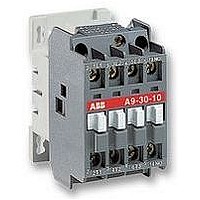A9-30-10-230V-50HZ ABB, A9-30-10-230V-50HZ Datasheet - Page 18

A9-30-10-230V-50HZ
Manufacturer Part Number
A9-30-10-230V-50HZ
Description
CONTACTOR, 3PST-NO, 230VAC, 7A, PANEL
Manufacturer
ABB
Datasheet
1.A9-30-10-230V-50HZ.pdf
(80 pages)
Specifications of A9-30-10-230V-50HZ
No. Of Poles
3
Contact Configuration
3PST-NO
Relay Mounting
Panel
Coil Voltage Vac Nom
230V
Length/height, External
74mm
Width
44mm
Nom Operating Power
4kW
External Width
44mm
Operating Voltage
690VAC
Switching Power Ac1
4kW
Switching Power Ac3
4kW
Switching Current Ac1
25A
Switching Current Ac3
9A
Load Current Inductive
9A
Load Current Resistive
25A
General
When starting, the motor has to overcome the load torque and inertia of the driven machine. During this phase, current must
remain within the limits acceptable by the mains.
Inertia, load torque and mains are commonly fixed data.
Although the type of starting reduces the inrush current as required, it also reduces the torque supplied by the motor. The result is a starting
time that varies according to the starting process used.
Star-delta starting
Sequence
Starting is a three-stage process:
1st stage - "Star" connection
Press the "On" button on the control circuit to close the KM2 "star" contactor. The KM1 "line" contactor then closes and the motor starts.
Countdown of programmed starting time (normally 6 to 10 s) then begins.
2nd stage - "Star" to "Delta" switching
When the programmed starting time is over, the KM2 "star" contactor opens.
3rd stage - "Delta" connection
A transition time (or dwelling time) of 50 ms is fixed between opening of the "star" contactor and closing of the "delta" contactor by the use of
TE5S timer. This prevents short circuit between "star" and "delta".
Note: When AF... contactor types are used as delta and star contactors or an A... contactor as star contactor with an AF... contactor as delta contactor, the use of a timer including a
dwelling time (or transition time) e.g. TE5S or similar is not necessary. A timer set for the starting duration in star connection is enough. An electrical interlock between star and delta is
mandatory such as VE 5 or through auxiliary contacts.
Furthermore, in open transition, the current interruption may reach up to 95 ms: it shall be checked that this duration is compatible with the application i.e. mainly if the decreasing in rotation
speed is acceptable during the starting phase.
ABB LIMITED
www.abb.com/lowvoltage
Star-Delta Starting
of Three-Phase Asynchronous Motors
email marketing.info@gb.abb.com
Technical Data
When starting:
– inrush current is reduced to a third of direct starting current,
– motor torque is reduced to a third or even less of direct starting
torque.
Transient currents are commonly read during star-delta switching.
Utilization
During the initial starting phase ("star" connection), the resistive torque
of the driven machine must remain, irrespective of speed, less than the
"star" motor torque until "star-delta" switching occurs.
This starting mode is therefore ideal for machines with no-load starting:
– machine-tools,
– centrifugal compressors,
– wood working machines, etc.
In order to prevent a high current peak, at least 80 - 85 % of
nominal speed must be reached before switching from star to
delta.
Precautions
Motor nominal voltage in delta connection must be equal to that of the
mains.
Example:
A motor for 400 V star-delta starting must be designed for 400 V in
"delta" connection. Its usual designation is "400 V / 690 V motor". The
motor must be constructed with 6 terminal windings.
Telephone 02476 368551
Facsimile 02476 368401
Return to main index
2/18














